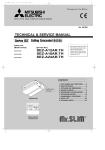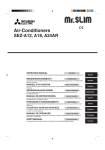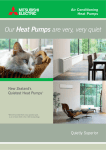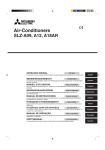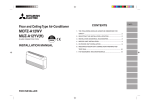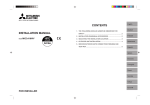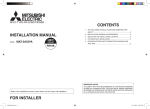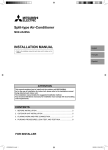Download Mitsubishi Electric SEZ-A24AR Installation manual
Transcript
Air-Conditioners SEZ-A12, A18, A24AR INSTALLATION MANUAL FOR INSTALLER For safe and correct use, please read this installation manual thoroughly before installing the air-conditioner unit. English Contents 1. 2. 3. 4. 5. 6. 7. 8. Safety precautions ................................................................................... 2 Selecting the installation location ............................................................. 2 Installation diagram & Accessories .......................................................... 3 Indoor unit installation .............................................................................. 4 Refrigerant piping work ............................................................................ 5 Drainage piping work ............................................................................... 7 Electrical work .......................................................................................... 8 Duct work ............................................................................................... 10 9. 10. 11. 12. Air filter installation ................................................................................. Test run .................................................................................................. Maintenance .......................................................................................... System control (Fig. 12-1) ...................................................................... 11 13 14 15 This Installation Manual describes only for the indoor unit and the connected outdoor unit of SUZ series. If the connected outdoor unit is MXZ series, refer to the Installation Manual for MXZ series. 1. Safety precautions • Please report to or take consent by the supply authority before connection to the system. • Be sure to read “The following should always be observed for safety” before installing the air conditioner. • Be sure to observe the cautions specified here as they include important items related to safety. • The indications and meanings are as follows. Warning: Could lead to death, serious injury, etc. : Indicates an action that must be avoided. Caution: Could lead to serious injury in particular environments when operated incorrectly. • After reading this manual, be sure to keep it together with the instruction manual in a handy place on the customer’s site. : Beware of hot surface. Warning: • Do not install it by yourself (customer). Incomplete installation could cause injury due to fire, electric shock, the unit falling or leakage of water. Consult the dealer from whom you purchased the unit or special installer. • Install the unit securely in a place which can bear the weight of the unit. When installed in an insufficient strong place, the unit could fall causing injured. • Use the specified wires to connect the indoor and outdoor units securely and attach the wires firmly to the terminal board connecting sections so the stress of the wires is not applied to the sections. Incomplete connecting and fixing could cause fire. • Do not use intermediate connection of the power cord or the extension cord and do not connect many devices to one AC outlet. It could cause a fire or an electric shock due to defective contact, defective insulation, exceeding the permissible current, etc. • Check that the refrigerant gas does not leak after installation has completed. Caution: • Perform grounding. Do not connect the ground wire to a gas pipe, water pipe arrester or telephone ground wire. Defective grounding could cause an electric shock. • Do not install the unit in a place where an inflammable gas leaks. If gas leaks and accumulates in the area surrounding the unit, it could cause an explosion. • Install a ground leakage breaker depending on the installation place (where it is humid). If a ground leakage breaker is not installed, it could cause an electric shock. : Indicates that important instructions must be followed. : Indicates a part which must be grounded. : Indicates that caution should be taken with rotating parts. : Indicates that the main switch must be turned off before servicing. : Beware of electric shock. Warning: Carefully read the labels affixed to the main unit. • Perform the installation securely referring to the installation manual. Incomplete installation could cause a personal injury due to fire, electric shock, the unit falling or leakage of water. • Perform electrical work according to the installation manual and be sure to use an exclusive circuit. If the capacity of the power circuit is insufficient or there is incomplete electrical work, it could result in a fire or an electric shock. • Attach the electrical part cover to the indoor unit and the service panel to the outdoor unit securely. If the electrical part cover in the indoor unit and/or the service panel in the outdoor unit are not attached securely, it could result in a fire or an electric shock due to dust, water, etc. • Be sure to use the part provided or specified parts for the installation work. The use of defective parts could cause an injury or leakage of water due to a fire, an electric shock, the unit falling, etc. • Ventilate the room if refrigerant leaks during operation. If the refrigerant comes in contact with a flame, poisonous gases will be released. • Perform the drainage/piping work securely according to the installation manual. If there is a defect in the drainage/piping work, water could drop from the unit and household goods could be wet and damaged. • Fasten a flare nut with a torque wrench as specified in this manual. When fastened too tight, a flare nut may broken after a long period and cause a leakage of refrigerant. 2. Selecting the installation location 2.1. Indoor unit • • • • Where airflow is not blocked. Where cool air spreads over the entire room. Where it is not exposed to direct sunshine. At a distance 1 m or more away from your TV and radio (to prevent picture from being distorted or noise from being generated). • In a place as far away as possible from fluorescent and incandescent lights (so the infrared remote control can operate the air conditioner normally). • Where the air filter can be removed and replaced easily. Warning: Mount the indoor unit into a ceiling strong enough to withstand the weight of the unit. 2.2. Outdoor unit • • • • • Where it is not exposed to strong wind. Where airflow is good and dustless. Where it is not exposed to rain and direct sunshine. Where neighbours are not annoyed by operation sound or hot air. Where rigid wall or support is available to prevent the increase of operation sound or vibration. • Where there is no risk of combustible gas leakage. • When installing the unit at a high level, be sure to fix the unit legs. • Where it is at least 3 m away from the antenna of TV set or radio. (Otherwise, images would be disturbed or noise would be generated.) 2 • Install the unit horizontally. Caution: Avoid the following places for installation where air conditioner trouble is liable to occur. • Where there is too much machine oil. • Salty environment as seaside areas. • Hot-spring areas. • Where sulfide gas exists. • Other special atmospheric areas. 3. Installation diagram & Accessories A ■ SEZ-A12/A18/A24AR Air inlet (rear side) dimensions 42 930 J H 215 240 12.5 120 (mm) Air inlet (bottom side) dimensions G J 7×100=700 955 24-ø2.9 holes I 450 2 77 39 77.5 100 215 7×100=700 955 24-ø2.9 holes 600 50 150 1 J 25 150 1016 930 J 240 120 51 12.5 29 5027 25 PLATE (A) 77.5 100 700 350 1000 680 5 3 38 60 (10) 50 6 40 50 100 7×100=700 880 9×2-ø2.9 holes 9 0 1070 3 20 or more 7 B 32.5 2×2-ø2.9 holes F 5 A D 20 C 94 60 25 1100 A 75 170 270 30 2 100 25 (10) 50 108 (1070) 3 8 350 E 2 Fig. 3-1 3.1. Indoor unit (Fig. 3-1) 1 2 3 5 6 7 8 9 0 A Air inlet (rear side) *Select the either back side or bottom side Electrical parts box Suspension bolt pitch Access door Service space (It is necessary to maintain a working service area from the ceiling.) Air inlet (bottom side) *Select the either back side or bottom side Suspension bolt M10 or 3/8 (procure locally) Air outlet duct flange Air outlet Refrigerant pipe (gas) ■ SUZ-A09/A12AR B C D E F G H I J Refrigerant pipe (liquid) Wiring entry Terminal block Drain plug R1 male Air outlet duct flange In case of bottom side suction, mount the PLATE (A) on the rear side. After installation, remove the transportation support PLATE (B). PLATE (B) × 2 Inlet size 3.2. Outdoor unit (Fig. 3-2) C Ventilation and service space ■ SUZ-A09/A12AR A A A 100 mm or more B 350 mm or more C Basically open 100 mm or more without only obstruction in front and on both sides of the unit. D 200 mm or more (Open two sides of left, right, or rear side.) ■ SUZ-A18/A24AR B D A 100 mm or more B 350 mm or more C 500 mm or more ■ SUZ-A18/A24AR When the piping is to be attached to a wall containing metals (tin plated) or metal netting, use a chemically treated wooden piece 20 mm or thicker between the wall and the piping or wrap 7 to 8 turns of insulation vinyl tape around the piping. C A A Units should be installed by licensed contractor accordingly to local code requirement. C B Fig. 3-2 3 3. Installation diagram & Accessories A B 3.3. Checking the indoor unit accessories (Fig. 3-3) 1 3 Check that the indoor unit is equipped with the following parts and accessories: A Refrigerant pipe parts 1 Pipe cover (for refrigerant piping joint) Small diameter × 1 Large diameter × 1 2 Bands for temporary tightening of pipe cover × 4 2 B Remote controller parts 3 Parts contained in the cardboard box × 1 Check the contents and read the explanations provided. C Air filter parts C 4 Parts contained in the bag × 1 Check the contents and read the explanations provided. 4 Refrigerant and drainage pipe sizes SEZ-A12AR SEZ-A18AR SEZ-A24AR Refrigerant Model Liquid OD ø6.35 (1/4") OD ø6.35 (1/4") OD ø6.35 (1/4") pipe Gas OD ø9.52(3/8") OD ø12.7 (1/2") OD ø15.88 (5/8") Drainage pipe Hard PVC pipe : OD ø26 (1") Fig. 3-3 4. Indoor unit installation 4.1. Suspension Structure (Give site of suspension strong structure.) 35 0 4.1.1. Wooden structure (Fig. 4-1) • Select tie beam (one-story houses) or second-floor girder (two-story houses) as reinforcement member. • Use sturdy beams of at least 6 cm square for beam pitch of 90 cm or less or of at least 9cm square for beam pitch of 90-180 cm. 70 10 A B A B C D C D Fig. 4-1 Ceiling Rafter Beam Roof beam 4.1.2. Ferro-concrete structures (Fig. 4-2) Secure the suspension bolts using the method shown, or use steel or wooden hangers, etc. to install the suspension bolts. G E Use inserts rated at 100-150 kg each (procure locally) F Suspension bolts M10 (3/8") (procure locally) G Steel reinforcing rod 4.1.3. Installing the suspension bolts E • Check the pitch of the suspension bolts. • Use the ø10 (3/8") suspension bolts (×4, procure locally). • Adhere strictly to the length of the suspension bolts. F Fig. 4-2 c a 4.2. Suspending the unit (Fig. 4-3) e Direct suspension method: Raise the unit and line it up with the suspension bolts, then secure it using both nuts. b d a b c d e Air outlet Air intake (selecting the either back side or bottom side.) Washer (procure locally) Nuts (procure locally) Suspension bolts (procure locally) b Fig. 4-3 4.3. Transportation support removal (Fig. 4-4) After installation, completely remove the transportation support because this part should only be used during transportation. A 3 screws B Transportation support A B A Fig. 4-4 4 5. Refrigerant piping work 5.1. Refrigerant pipe (Fig. 5-1) (A) a Maximum difference between heights of indoor unit and outdoor unit, the length of refrigerant piping and the number of bends in piping are within limits shown below. (B) b Models a Indoor unit b Outdoor unit (A) Pipe length (one way) max. 20 m max. 30 m max. 30 m SEZ-A12AR SEZ-A18AR SEZ-A24AR (C) Fig. 5-1 (B) Height difference max. 12 m max. 15 m max. 15 m (C) Number of bends (one way) max. of 10 max. of 10 max. of 10 *1: Height difference limitations are binding regardless of which unit, indoor or outdoor, is positioned higher. 2 SEZ-A12:Ø9.52 SEZ-A18:Ø12.7 SEZ-A24:Ø15.88 1 Indoor unit 2 Outdoor unit Fig. 5-2 Pipe length Ø6.35 1 Avoid the following places for installation where air conditioner trouble is liable to occur. • Where there is too much oil such as for machine or cooking. • Salty environment as seaside areas. • Hot-spring areas. • Where sulfide gas exists. • Other special atmospheric areas. • This unit has flared connections on both indoor and outdoor sides. (Fig. 5-2) • Refrigerant pipes are used to connect the indoor and outdoor units as shown in the figure below. • Insulate both refrigerant and drainage piping completely to prevent condensation. • Refrigerant adjustment … If pipe length exceeds 7 m, additional refrigerant (R410A) charge is required. (The outdoor unit is charged with refrigerant for 7 m pipe length.) 7m maximum No additional charge required Exceeding 7m Additional charge required – Refrigerant to be added SEZ-A12AR:30g/m SEZ-A18AR:50g/m SEZ-A24AR:50g/m Piping preparation • Refrigerant pipes of 3, 5, 7, 10 and 15 m are available as optional items. (1) Table below shows the specifications of pipes commercially available. Model Pipe For liquid For gas For liquid SEZ-A18AR For gas For liquid SEZ-A24AR For gas SEZ-A12AR Outside diameter mm inch 6.35 9.52 6.35 12.7 6.35 15.88 1/4 3/8 1/4 1/2 1/4 5/8 Min wall thickness Insulation thickness Insulation material 0.8 mm 0.8 mm 0.8 mm 0.8 mm 0.8 mm 1.0 mm 8 mm 8 mm 8 mm 8 mm 8 mm 8 mm Heat resisting foam plastic 0.045 specific gravity (2) Ensure that the 2 refrigerant pipes are well insulated to prevent condensation. (3) Refrigerant pipe bending radius must be 10 cm or more. Caution: Using careful insulation of specified thickness. Excessive thickness prevents storage behind the indoor unit and smaller thickness causes dew drippage. 5 5. Refrigerant piping work b a c d 90° e a b c d e f f Copper tubes Good No good Tilted Uneven Burred Fig. 5-3 • Main cause of gas leakage is defect in flaring work. Carry out correct flaring work in the following procedure. 5.2.1. Pipe cutting (Fig. 5-3) • Using a pipe cutter cut the copper tube correctly. 5.2.2. Burrs removal (Fig. 5-4) b a 5.2. Flaring work a b c d c d Burr Copper tube/pipe Spare reamer Pipe cutter • Completely remove all burrs from the cut cross section of pipe/tube. • Put the end of the copper tube/pipe to downward direction as you remove burrs in order to avoid burrs drop in the tubing. Fig. 5-4 5.2.3. Putting nut on (Fig. 5-5) a a Flare nut b Copper tube • Remove flare nuts attached to indoor and outdoor unit, then put them on pipe/tube having completed burr removal. (not possible to put them on after flaring work) b Fig. 5-5 a A a b c d e e b d b c c Flaring tool Die Copper tube Flare nut Yoke 5.2.4. Flaring work (Fig. 5-6) • Carry out flaring work using flaring tool as shown at the right. Pipe diameter (mm) Fig. 5-6 6.35 9.52 12.7 15.88 Dimension A (mm) When the tool for R410A is used Clutch type 0 - 0.5 0 - 0.5 0 - 0.5 0 - 0.5 +0 B -0.4 (mm) 9.1 13.2 16.6 19.7 Firmly hold copper tube in a die in the dimension shown in the table at above. a B 5.2.5. Check (Fig. 5-7) b d e f g • Compare the flared work with a figure in right side hand. • If flare is noted to be defective, cut off the flared section and do flaring work again. h a b c d e c i Fig. 5-7 Smooth all around Inside is shining without any scratches Even length all around Too much Tilted f g h i Scratch on flared plane Cracked Uneven Bad examples 5.3. Pipe connection (Fig.5-8) • Apply a thin coat of refrigeration oil on the seat surface of pipe. • For connection first align the center, then tighten the first 3 to 4 turns of flare nut. • Use tightening torque table below as a guideline for indoor unit side union joint section, and tighten using two wrenches. Excessive tightening damages the flare section. Copper pipe O.D. (mm) ø6.35 ø9.52 ø12.7 ø15.88 Fig. 5-8 g f c b h a d e c i c e a b c d e b f g h i Fig. 5-9 6 Indoor unit (main unit) 1 Pipe cover 2 Band Flare joint Refrigerant pipe and insulating material (must be supplied locally) Position the pipe cover so that the end is in firm contact with the main unit. Fasten it so that there is no clearance. Allow no clearance Separator sheet Cut off the remainder band Flare nut O.D. (mm) 17 22 26 29 Tightening torque (N·m) 14 - 18 34 - 42 49 - 61 68 - 82 Warning: Be careful of flying flare nut! (Internally pressurized) Remove the flare nut as follows: 1. Loosen the nut until you hear a hissing noise. 2. Do not remove the nut until the gas has been completely released (i.e., hissing noise stops). 3. Check that the gas has been completely released, and then remove the nut. Outdoor unit connection Connect pipes to stop valve pipe joint of the outdoor unit in the same manner applied for indoor unit. • For tightening use a torque wrench or spanner, and use the same tightening torque applied for indoor unit. Refrigerant pipe insulation (Fig. 5-9) (1) Peel the separator sheet off the accompanying pipe cover, and wrap it around the refrigerant pipe, making sure that the side which is slit faces upwards. (2) Be sure to fix both ends of the pipe cover using an attachment band (ensure that the band’s joint faces upwards). (3) Stick vinyl tape on the joint positions. 5. Refrigerant piping work 5.4. Purging procedures leak test PURGING PROCEDURES Remove the gage manifold valve quickly from the service port of the stop valve. Connect the refrigerant pipes (both the liquid and gas pipes) between the indoor and the outdoor units. Remove the service port cap of the stop valve on the side of the outdoor unit gas pipe. (The stop valve will not work in its initial state fresh out of the factory (totally closed with cap on).) Connect the gage manifold valve and the vacuum pump to the service port of the stop valve on the gas pipe side of the outdoor unit. After refrigerant pipes are connected and evacuated, fully open all stop valves on gas and liquid pipe sides. Operating without fully opening lowers the performance and causes trouble. Pipe length : 7 m maximum No gas charge is needed. Pipe length exceeding 7 m Charge the prescribed amount of gas. Run the vacuum pump. (Vacuumize for more than 15 minutes.) Tighten the cap to the service port to obtain the initial status. Check the vacuum with the gage manifold valve, then close the gage manifold valve, and stop the vacuum pump. Retighten the cap Leave it as is for one or two minutes. Make sure the pointer of the gage manifold valve remains in the same position. Confirm that the pressure gage show -0.101MPa (-760 mmHg) *Close *Open Hexagonal wrench *4 to 5 turns Stop valve Leak test -0.101MPa Compound pressure Stop valve (-760 mmHg) gauge (for R410A) Pressure gauge (for R410A) Gauge manifold valve (for R410A) Handle High Handle Low Charge hose Stop (for R410A) valve Vacuum (or the vacuum Service port pump pump with the Window function to Adapter for prevent the back Charge hose preventing flow) (for R410A) the back flow 6. Drainage piping work 6.1. Drainage pipe connection (Fig. 6-1) H2 H1 Indoor unit’s drainage pipe A • The drainage pipe should be arranged so that the discharge end is lower than the other end, as shown in the figure opposite. • Place the trap outside the unit. • After connecting the drainage pipe, make sure that water is discharged properly and that there are no leaks. A Drainage piping connection 1 RP male. B Trap Outdoor unit drainage pipe connection B When drainage piping is necessary, use the drain pan (supplied as an option). H1 : 50 mm or more H2 : 1/2 H1 or more Fig. 6-1 7 7. Electrical work 7.1. Power supply (Fig. 7-1) (1) SEZ-A12AR (1:1 SYSTEM) A B 3 2 N 1 2 Electrical specification Power supply (1 phase ~/N, 220-240V, 50Hz) L N D E H F N L C 3 2 N A G (2) SEZ-A18/A24AR (1:1 SYSTEM) OR MULTI SYSTEM A 1 2 3 2 N 10 20 20 Warning: • Do not use intermediate connection of the power cord, etc. or an extension cord or connect many devices to one AC outlet. It could cause a fire or electric shock due to defective contact, defective insulation, exceeding the permissible current, etc. • Supply power should be taken from independently branched circuit. If not, it could cause a fire. • A switch with at least 3 mm contact separation in each pole shall be provided by the air conditioner installation. A B C D B Input capacity Main Switch/Fuse (A) SEZ-A12AR SEZ-A18AR SEZ-A24AR Terminal block Indoor unit (Refer to Fig. 7-2) Breaker 4-core cable ((2) · · · 2-core cable) E F G H 3-core cable Power supply Outdoor unit (Refer to Fig. 7-3) Remote controller L N D E A H N L F N L F C G 3 N L N A E C Fig. 7-1 1 4 5 6 7.2. Indoor wire connection (Fig. 7-2) Work procedure 1.Remove 2 screws to detach the electric component cover. 2.Route each cable through the wiring intake into the electric component box. (Procure power cable and in-out connecting cable locally and use remote control cable supplied with the unit.) 3.Securely connect the power cable and the in-out connecting cable and the remote control cable to the terminal blocks. 4.Secure the cables with clamps inside the electric component box. 5.Attach the electric component cover as it was. • Fix power supply cable and indoor/outdoor cable to control box by using buffer bushing for tensile forse. (PG connection or the like.) 2 4 6 5 3 7 8 9 0 Fig. 7-2 8 Warning: • Attach the electrical part cover securely. If it is attached incorrectly, it could result in a fire, electric shock due to dust, water, etc. • Use the specified indoor/outdoor unit connecting wire to connect the indoor and outdoor units and fix the wire to the terminal bed securely so that no stress is applied to the connecting section of the terminal bed. Incomplete connection or fixing of the wire could result in a fire. • The wiring configuration of the indoor unit’s fan motor is for a 50Hz power supply. The wiring must be reconfigured if a 60Hz power supply is used. Refer to the wiring diagram for details. 1 2 3 4 5 6 7 8 9 0 Entry for remote controller cable Entry for power supply cable and Indoor-Outdoor connecting cable Cable clamp Remote controller terminal Power supply terminal Indoor/Outdoor unit connecting terminal To remote controller To power supply source To outdoor unit Indoor controller 7. Electrical work (1) SEZ-A12AR (1:1 SYSTEM) L 3 (2) SEZ-A18/24AR (1:1 SYSTEM) OR MULTI SYSTEM N N 3 2 L 3 5 2 6 1 2 1 1 L 7 5 N 3 2 2 6 1 2 N 7 N 3 2 N 5 N 3 2 4 4 Fig. 7-3 1 • Perform wiring as shown in the diagram to the lower left. (Procure the cable locally). (Fig. 7-3) Make sure to use cables of the correct polarity only. 1 Connecting cable 2 Power supply cable 4 core VVF cable 3 core with ground IEC cord • SEZ-A12:1.0 mm2 or more • SEZ-A12:1.0 mm2 or more • SEZ-A18, A24:1.5 mm2 or more • SEZ-A18, A24:1.5 mm2 or more Colors Colors N: Blue N: Blue 2 : Brown L : Brown 3 : Red : Green/Yellow : Green/Yellow 3 Indoor 4 Outdoor 5 Always install an earth longer than other cables 6 Remote controller cable Wire No × size (mm2) : Cable 2C × 0.69 This wire accessory of remote controller (wire length : 10m, non-polar) 7 Remote controller • Connect the terminal blocks as shown in the diagram below. (Fig. 7-4) 15 mm 1 Loosen terminal screw 2 Terminal bed 65 mm 2 (1) Use care not to make mis-wiring. (2) Firmly tighten the terminal screws to prevent then from loosening. (3) After tightening, pull the wires lightly to confirm that they do not move. Fig. 7-4 7.3. Remote controller B A 7.3.1. For wired remote controller 30 1) Installing procedures (1) Select an installing position for the remote controller. (Fig. 7-5) The temperature sensors are located on both remote controller and indoor unit. s Procure the following parts locally: Two piece switch box Thin copper conduit tube Lock nuts and bushings 30 30 83.5 46 C A E F I G H 120 C D Fig. 7-5 B-1. B-2. B H H I J I (2) Seal the service entrance for the remote controller cord with putty to prevent possible invasion of dew drops, water, cockroaches or worms. (Fig. 7-6) A For installation in the switch box: B For direct installation on the wall select one of the following: • Prepare a hole through the wall to pass the remote controller cord (in order to run the remote controller cord from the back), then seal the hole with putty. • Run the remote controller cord through the cut-out upper case, then seal the cutout notch with putty similarly as above. B-1. To lead the remote controller cord from the back of the controller: B-2. To run the remote controller cord through the upper portion: (3) For direct installation on the wall C D E F G H I J Fig. 7-6 A 1 Wall Conduit Lock nut Bushing Switch box Remote controller cord Seal with putty Wood screw 2) Connecting procedures (Fig. 7-7) 1 Connect the remote controller cord to the terminal block. ON 2 3 4 ON 1 2 3 4 C AB A Remote controller profile B Required clearances surrounding the remote controller C Installation pitch TB6 B Fig. 7-7 <SW No. 1> A To the terminal block on the indoor unit B TB6 (No polarity) 2 Set the dip switch No.1 shown below when using two remote controller’s for the same group. C Dip switches Setting the dip switches The dip switches are at the bottom of the remote controller. Remote controller Main/ Sub and other function settings are performed using these switches. Ordinarily, only change the Main/Sub setting of SW No.1. (The factory settings are all “ON”.) <SW No. 3> SW contents Main Remote controller Main/Sub setting SW contents Main Cooling/heating display in AUTO mode ON/OFF Comment Main/Sub Set one of the two remote controllers at one group to “Main” ON/OFF Yes/No When you do not want to display “Cooling” and “Heating” in the Auto mode, set to “No”. SW contents Main When remote controller power turned on <SW No. 4> ON/OFF Normally on/Timer mode on When you want to return to the timer mode when the power is restored after a power failure when a Program timer is connected, select “Timer mode”. SW contents Main Intake temperature display ON/OFF Comment Yes/No When you do not want to display the intake temperature, set to “No”. Comment <SW No. 2> Comment 9 7. Electrical work 7.4. Outdoor unit (Fig. 7-8) A Cord clamp. B Service panel C Fixing screws • Both end of connecting cable (extension wire) are peeled off. When too long, or connected by cutting off the middle, peel off power supply cable to the size given in the figure. • Be careful not to contact connecting cable with piping. B Caution: • Use care not to make mis-wiring. (Fig. 7-9) • Firmly tighten the terminal screws to prevent them from loosening. • After tightening, pull the wires lightly to confirm that they do not move. C A Warning: • Be sure to attach the service panel of the outdoor unit securely. If it is not attached correctly, it could result in a fire or an electric shock due to dust, water, etc. • Tighten terminal screws securely. • Wiring should be done so that the power lines are not subject to tension. Otherwise, heat may be generated or fire may occur. Fig. 7-8 A C B • Connect cable from the indoor unit correctly on the terminal-block. • Use the same terminal block and polarity as is used with the indoor unit. • For aftercare maintenance, give extra length to connecting cable. A Loosen terminal screw B Terminal block C Lead wire Fig. 7-9 8. Duct work At the time of shippting from factory B C Use the canvas duct for connecting the indoor unit and the duct. (Fig. 8-1) Use fire-proof material for the duct parts. Make sure that the duct has sufficient heat insulation. A N D O M I K P H L E J F G In case of bottom-side suction Q Remove the panel attached to the bottom side, and mount it on the rear side. Fig. 8-1 10 A B C D E F G H I J K L M N O P Q Electrical parts box Canvas duct Air outlet flange Air outlet duct Air filter (procure locally) Air outlet grille Air intake grille Ceiling Drainage pan Air intake Air outlet Allow clearance to avoid short cycling. Indoor unit Earth terminal Earth cable 850 mm or more Safety net (procured locally) Notes: • The fan and motor are dangerous if handled during operation. For this reason, be sure to install the indoor unit at least 850mm from the air intake grill G. If it is not possible to put more than 850 mm of distance between the air intake grill and the indoor unit, install the safety net Q (locally procured). • Connect the main body of the air conditioner and the duct so that their potentials are equal. • Connect an earth cable O from the air outlet flange C to the earth terminal N. Then, connect another earth cable O from the earth terminal N to the air outlet duct D. • Be sure to install an air filter (procure locally) and an air outlet duct. 9. Air filter installation 1 9.1. Confirmation of enclosed parts (Fig. 9-1) 2 • Please ensure all the parts shown below are present before starting installation. 1 2 3 4 5 6 Cut out 3 4 5 Filter × 1 Filter rail × 1 Filter rail × 1 ST. screw (4 × 10) × 14 Clamp × 2 Seal × 2 Hole Cut out 6 Fig. 9-1 9.2. Filter rail installation (Rear air intake) (Fig. 9-2) 2 A 1 ■ Please select air intake direction A or B 1. Transportation support remove (Throw away). 2. Please attach filter rail 2 as per the diagram (screw × 6). Please connect rails 2 3 carefully. 3. Please attach filter rail 3 as per the diagram (screw × 6). Please connect rails 2 3 carefully. 4. Seal 6 Upright position here. A Control box B Drain pan C Air tight seal Level with edge B 3 A C 4 C Fig. 9-2 A 2 9.3. Filter rail installation (Bottom air intake) (Fig. 9-3) 1 4 1. Transportation support remove (Throw away). 2. Please move the plate position. (Please use the screws removed.) 3. Please attach filter rail 2 as per the diagram (screw × 6). Please connect rails 2 3 carefully. 4. Please attach filter rail 3 as per the diagram (screw × 6). Please connect rails 2 3 carefully. 5. Clamp 5 (Attach the clamps 5 with screw × 2) Upright position here. 6. Seal 6 Upright position here. A Control box C Air tight seal Level with edge 5 4 5 A 3 C C 6 Fig. 9-3 11 9. Air filter installation A 9.4. Filter installation points (Rear air intake) (Fig. 9-4) 1. Insert the filter into rail 2 2. Hook the filter onto rail 3 E 1 D A B D E F Control box Drain pan Filter Rail 2 Rail 3 2 B F Fig. 9-4 A 9.5. Filter installation points (Bottom air intake) (Fig. 9-5) 1. Insert the filter into rail 2 2. Hook the filter onto rail 3 3. Bend the clamp to hold the filter. A D E F G H 1 2 F E D H A G F E Fig. 9-5 12 Control box Filter 1 Rail 2 Rail 3 Bend Clamp 5 10.Test run 10.1. Before test run s After completing installation and the wiring and piping of the indoor and outdoor units, check for refrigerant leakage, looseness in the power supply or control wiring, wrong polarity, and no disconnection of one phase in the supply. s Use a 500-volt megohmmeter to check that the resistance between the power supply terminals and ground is at least 1.0 MΩ. s Do not carry out this test on the control wiring (low voltage circuit) terminals. Warning: Do not use the air conditioner if the insulation resistance is less than 1.0 MΩ. Insulation resistance After installation or after the power source to the unit has been cut for an extended period, the insulation resistance will drop below 1 MΩ due to refrigerant accumulating in the compressor. This is not a malfunction. Perform the following procedures. 1. Remove the wires from the compressor and measure the insulation resistance of the compressor. 2. If the insulation resistance is below 1 MΩ, the compressor is faulty or the resistance dropped due the accumulation of refrigerant in the compressor. F E DC B A 3. After connecting the wires to the compressor, the compressor will start to warm up after power is supplied. After supplying power for the times indicated below, measure the insulation resistance again. • The insulation resistance drops due to accumulation of refrigerant in the compressor. The resistance will rise above 1 MΩ after the compressor is warmed up for two to three hours. (The time necessary to warm up the compressor varies according to atmospheric conditions and refrigerant accumulation.) • To operate the compressor with refrigerant accumulated in the compressor, the compressor must be warmed up at least 12 hours to prevent breakdown. 4. If the insulation resistance rises above 1 MΩ, the compressor is not faulty. Caution: • The compressor will not operate unless the power supply phase connection is correct. • Turn on the power at least 12 hours before starting operation. - Starting operation immediately after turning on the main power switch can result in severe damage to internal parts. Keep the power switch turned on during the operational season. 10.2. Test run The following 3 methods are available. 10.2.1. Using wired remote controller (Fig. 10-1) CENTRALLY CONTROLLED ON 1 2 3 4 1Hr. OFF ˚C CLOCK CHECK ˚C STAND BY DEFROST ERROR CODE NOT AVAILABLE TEMP. FILTER CHECK MODE TEST RUN FUNCTION ON/OFF FILTER 5 6 7 8 CHECK TEST TIMER SET G H I Turn on the power at least 12 hours before the test run. Press the [TEST] button twice. ➡ “TEST RUN” liquid crystal display Press the [Mode selection] button. ➡ Make sure that wind is blown out. Press the [Mode selection] button and switch to the cooling (or heating) mode. ➡ Make sure that cold (or warm) wind is blown out. Press the [Fan speed] button. ➡ Make sure that the wind speed is switched. Check operation of the outdoor unit fan. Release test run by pressing the [ON/OFF] button. ➡ Stop After the checks, always turn off the power. A B C D E F M Fig. 10-1 B CENTRALLY CONTROLLED ˚C CLOCK FILTER ˚C STAND BY DEFROST INDOOR UNIT ADDRESS NO CHECK MODE ERROR CODE OA UNIT ADDRESS NO NOT AVAILABLE CHECK E C TEMP. FUNCTION D a) ON/OFF CENTRALLY CONTROLLED FILTER ON OFF CHECK CHECK TEST TIMER SET ˚C CLOCK INDOOR UNIT ADDRESS NO FILTER CHECK MODE ERROR CODE OA UNIT ADDRESS NO A Fig. 10-2 10.3. Self-check 10.3.1. Wired remote controller (Fig. 10-2) 1Hr. ˚C STAND BY DEFROST G H I M 1Hr. ON OFF CHECK ON/OFF button Test run display Indoor temperature liquid line temperature display ON/OFF lamp Power display Error code display Test run remaining time display Set temperature button Mode selection button Fan speed button TEST button NOT AVAILABLE FUNCTION 1 2 3 4 Turn on the power. Press the [CHECK] button twice. Set refrigerant address with [TEMP] button if system control is used. Press the [ON/OFF] button to stop the self-check. A B C D CHECK button Refrigerant address TEMP. button IC: Indoor unit OC: Outdoor unit E Check code • For description of each check code, refer to the following table. 1 Check code 5101 5102 2503 2502 1503 0405, 1501, 4210, 5102 6831~6834 6800 8000 FFFF Symptom Room temperature thermistor error RT12, 13 thermistor error Drain sensor error Drain pump error Freezing safeguard operation Outdoor unit error Signal error between remote controller and indoor units Communication error between indoor and outdoor units No alarm history No unit • On wired remote controller 1 Check code displayed in the LCD. 13 10.Test run 10.4. AUTO RESTART FUNCTION • This model is equipped with the AUTO RESTART FUNCTION. When the indoor unit is controlled with the remote controller, the operation mode, set temperature, and the fan speed are memorized by the indoor controller board. The auto restart function sets to work the moment the power has restored after power failure, then, the unit will restart automatically. Notes: • The operation settings are memorized when 10 seconds have passed after the remote controller was operated. • • If the main power is turned off or a power failure occurs while AUTO START/ STOP timer is active, the timer setting is cancelled. As this model is equipped with the auto restart function, the air conditioner should start operating at the same time that a power has restored. If the unit has been off with the remote controller before power failure, the auto restart function does not work as the power button of the remote controller is off. To prevent breaker off due to the rush of starting current, systematize other home appliance not to turn on at the same time. 10.5. Indoor temperature position change function (Fig. 10-3) C1 This model is equipped with the indoor temperature position change function. Detection of room temperature can be changed into remote controller’s internal sensor. 1 Power supply is turn off. 2 Cut the JP14 jumper wire of the indoor controller board with a pair of nippers. A Indoor controller board CNC CNP FAN1 FAN2 A C412 CND JP14 52C RC00J590B Fig. 10-3 11.Maintenance 11.1. Gas charge (Fig. 11-1) B E A C D F M G L K H I J A B C D E F G Indoor unit Union Liquid pipe Gas pipe Stop valve Outdoor unit Refrigerant gas cylinder operating valve H Refrigerant gas cylinder for R410A with siphon I Refrigerant (liquid) J Electronic scale for refrigerant charging K Charge hose (for R410A) L Gauge manifold valve (for R410A) M Service port Fig. 11-1 14 1. Connect gas cylinder to the service port of stop valve (3-way). 2. Execute air purge of the pipe (or hose) coming from refrigerant gas cylinder. 3. Replenish specified amount of refrigerant, while running the air conditioner for cooling. Note: In case of adding refrigerant, comply with the quantity specified for the refrigerating cycle. Caution: • Do not discharge the refrigerant into the atmosphere. Take care not to discharge refrigerant into the atmosphere during installation, reinstallation, or repairs to the refrigerant circuit. • For additional charging, charge the refrigerant from liquid phase of the gas cylinder. If the refrigerant is charged from the gas phase, composition change may occur in the refrigerant inside the cylinder and the outdoor unit. In this case, ability of the refrigerating cycle decreases or normal operation can be impossible. However, charging the liquid refrigerant all at once may cause the compressor to be locked. Thus, charge the refrigerant slowly. To maintain the high pressure of the gas cylinder, warm the gas cylinder with warm water (under 40°C) during cold season. But never use naked fire or steam. 12.System control (Fig. 12-1) FAN2 1 Wiring from the Remote Control This wire is connected to terminal block for remote controller of the indoor unit (nonpolar). 2 When a Different Refrigerant System Grouping is Used. Up to 4 refrigerant systems can be controlled as one group using the MA remote controller. There is need to set up JP17, JP18 jumper wire of indoor controller board. Note: In single refrigerant system, there in no need of wiring 2, and there is need to cut JP17, JP18 jumper wire of indoor controller board. The total extention of remote control cable is a maximum of 100 m. CNC CNP FAN1 C1 I C412 JP17 CND JP17,18 Outdoor unit Indoor unit (only SEZ) Master remote controller Subordinate remote controller Standard 1:1 (Refrigerant address = 00) Simultaneous two groups (Refrigerant address = 01) Simultaneous three groups (Refrigerant address = 02) Simultaneous four groups (Refrigerant address = 03) Indoor controller board. A A A A B E B F B G B H 1 2 Refrigerant E address = 00 The setup at the time shipment. In single refrigerant system, there is no need to cut JP17, JP18. F Refrigerant address = 01 Cut the JP17 jumper wire of indoor controller board with a pair of nipper. G Refrigerant address = 02 Cut the JP18 jumper wire of indoor controller board with a pair of nipper. H Refrigerant address = 03 Cut the JP17, JP18 jumper wire of indoor controller board with a pair of nipper. 52C RC00J590B A B C D E F G H I JP18 2 C 2 1 D Fig. 12-1 15 This product is designed and intended for use in the residential, commercial and light-industrial environment. The product at hand is based on the following EU regulations: • • Low Voltage Directive 73/23/ EEC Electromagnetic Compatibility Directive 89/ 336/ EEC Please be sure to put the contact address/telephone number on this manual before handing it to the customer. HEAD OFFICE: MITSUBISHI DENKI BLDG., 2-2-3, MARUNOUCHI, CHIYODA-KU, TOKYO 100-8310, JAPAN BG79S993H01 Printed in Thailand


















